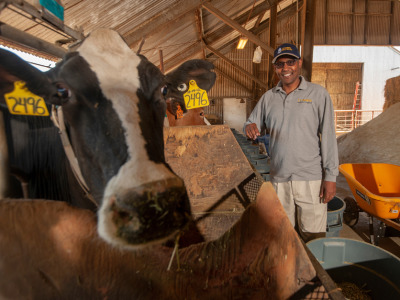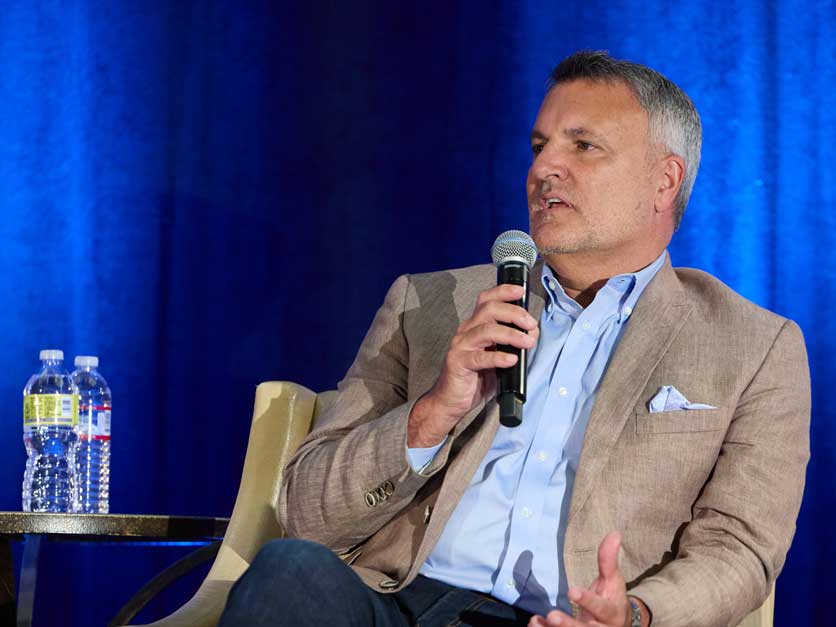Animal health and seed companies are working on new products that promise to reduce methane emissions released in the digestive process of cows by as much as 30%. Yet some California dairy farmers, weary of aggressive state mandates, fear federal approval of new feed additives could lead lawmakers or state agencies to force their adoption through regulations, upending efforts to create voluntary carbon credit markets.
The issue is dividing the dairy industry and igniting concerns that California could fall behind on its climate pledge by expediting an exodus of cows to states with more relaxed regulatory environments.
In 2016 California passed Senate Bill 1383, pivotal climate legislation that set the world’s first mandate for cutting methane emissions, with a target of a 40% reduction in livestock emissions by 2030.
Agricultural groups pushed hard against incorporating within that goal any emissions from enteric fermentation. As a compromise, SB 1383 prohibits the Air Resources Board (CARB) from regulating enteric emissions until the state determines the feed additive products are cost effective, accepted by consumers, do not impact animal productivity or hurt animal or public health, and are scientifically proven to reduce emissions—and the agency may soon be able to check off those boxes.
SB 1383 triggered a years-long lobbying campaign for dedicating a steady stream of cap-and-trade revenue to grant programs that incentivize dairy digesters and alternative management practices for slashing methane emissions. The state has allocated $385 million to date and academics are hopeful California is on track to achieving its goal.
Despite the documented progress, CARB has heeded calls from environmental justice advocates who oppose grants for dairies, alleging the money enables the expansion of large polluting facilities.
In January CARB approved an update to its AB 32 Climate Scoping Plan, the state’s framework for setting goals that guide regulatory policies. The document calls for reconsidering dairies in the Low Carbon Fuel Standard (LCFS) program, potentially ending carbon credits for the biogas the digesters generate.
 UC Davis Professor Ermias Kebreab
UC Davis Professor Ermias Kebreab“They're saying that a polluter should not be rewarded for polluting,” Anja Raudabaugh, CEO of Western United Dairies, told Agri-Pulse, “and that the taxpayer incentive dollars that built these digesters were only there to stimulate and incentivize an industry, not keep it afloat.”
Raudabaugh argued that dairy farmers took a risk by investing in digesters when the technology was still new and now the bulk of the state’s methane reductions are coming from digesters. It is the only industry in the world regulated for methane and the only one “that has done something about methane.”
In the report, staff note that LCFS has fostered a growing market for alternative fuels like renewable diesel, sustainable aviation fuel, biomethane and electricity, and it has displaced the market share for gasoline and diesel. The agency is developing a proposal to increase the stringency for LCFS starting in 2030 and will begin the rulemaking process later this year. The debates stand to be contentious for the dairy industry.
The scoping plan seeks to “ensure low-income communities, tribes and communities of color do not experience increases in existing air pollution disparities” and that alternative fuels “do not incentivize feedstocks with little to no [greenhouse gas] reductions from a lifecycle perspective.” It notes that increasing alternative fuels should not lead to adverse impacts in the food supply either.
According to the plan, if demand for dairy products holds steady or increases, the state will need more farmers to adopt strategies for managing manure emissions and for enteric mitigation. It calls for CARB to consider regulations to ensure the state achieves its 2030 target.
Raudabaugh said such a regulation would require every farmer to reduce emissions by 40% and the only option for smaller producers would be reducing their herd sizes. But Dairy Cares Executive Director Michael Boccadoro cautioned that CARB recognizes that a regulation would lead to “massive leakage” by moving California’s methane emissions to another state.
Along with LCFS, incentive dollars are drying up. The state is facing a steep budget deficit and the Newsom administration does not plan to add any new funding for the manure grants, though digesters still qualify for a tax credit under the federal Inflation Reduction Act.
Even without additional funding, dairies are on a trajectory to reduce methane emissions more than 40% by 2030, UC Davis researchers reported in December. They factored in about 200 digesters under construction and a “moderate feed additive strategy” for enteric emissions. Soon after the release of the report, Boccadoro told the board that any suggestions the incentive-based approach is not working “are frankly false.”
Yet Olivia Seideman, a policy coordinator for the Leadership Counsel for Justice & Accountability, chastised the LCFS program for considering biomethane derived from manure as a carbon-negative fuel. Seideman argued it “creates massive profit potential for the production of manure and consequent methane, water and air pollution.”
The board tasked the agency with leading a full lifecycle analysis of biogas production and deployment. Its skepticism over digesters is placing more pressure to approve and adopt feed additives.
Ermias Kebreab, a professor in sustainable agriculture and a coauthor on the UC Davis study, told Agri-Pulse it would be hard for the state to hit its methane goal without additives. While the FDA is on track to approve at least one product licensed by Elanco in 2024, the European Union has already approved several. Kebreab said the slower approval process is due to the FDA classifying feed additives as veterinary drugs, requiring a more thorough review process.
EU researchers have conducted more than 40 experiments showing no impacts to animal or human health, with long-term studies underway as well, according to Kebreab. The products have not been tested in Jersey cows, which make up about half of California’s dairy herd. But Kebreab said the breed does not make a difference with safety, since the inhibitors go after characteristics present in any ruminants. The effectiveness in reducing emissions does vary some between beef and dairy cattle and by diet.
He acknowledged more research is needed before widescale adoption in California. To be accepted for carbon credits, he explained, each product will require at least three papers published independently in peer-reviewed journals. One study involving lemongrass in Mexico, for example, is not enough. This allows researchers like Kebreab to perform a meta-analysis of the studies to identify the best practices for California livestock. Diets in tropical countries would not have the same methane benefits in a Mediterranean climate.
Organic dairy producers have also raised concerns over using seaweed as an additive, since those farmers use it, rather than antibiotics, to control pink eye in cows. They fear a spike in demand for seaweed could price them out of the market, according to Raudabaugh. Kebreab assured that the research has focused on a separate type of seaweed, one that has never been used commercially. Though several companies are working on seaweed-based products, Kebreab said the manufacturing process is much more complicated for biological ingredients than for synthetic, since it requires an aquaculture system and certain environments.
He is working with an international consortium of researchers to develop guidelines on conducting research and regulatory protocols to rule out any undue claims on additives.
In anticipation of federal approval, lawmakers in the Legislature have introduced two spot bills this month that address feed additives but are light on details. One would grant the CDFA secretary the final determination on whether a product is safe for livestock and consumers. The other would task CARB with developing compliance protocols for incentivizing feed additives. The legislation has raised concerns with Raudabaugh about setting policy goals ahead of the research and when consumer acceptance is still murky.
 Michael Boccadoro, Dairy Cares
Michael Boccadoro, Dairy CaresThe dairy industry has been on edge in recent years as lawmakers have introduced measures targeting confined animal feeding operations (CAFOs). Former Assemblymember Adrin Nazarian of Sherman Oaks filed a measure last year that would have banned new CAFOs and expansions on existing facilities, fining violators up to $10,000 a day. The Agriculture Committee refused to take up the measure, drawing heated protests from animal rights activists.
Both Raudabaugh and Boccadoro worried that a regulatory mandate on additives from the Legislature or CARB would upend a voluntary carbon credit market, forcing farmers to shoulder the cost, which could forfeit any emissions benefits and potentially exacerbate a trend of cows leaving California.
Don’t miss a beat! It’s easy to sign up for a FREE month of Agri-Pulse news! For the latest on what’s happening in Washington, D.C. and around the country in agriculture, just click here.
However, Boccadoro is confident the state will not do that, since such a regulation would remove the ability to create credits. He stressed that the movement toward additives is coming from major food and beverage companies, like Starbucks, that have set goals for reducing carbon emissions in their products and will either pay more for lower carbon milk or buy those credits in the supply chain, a practice known as carbon insets. While it is too early to know the cost for additives, Boccadoro calculated that even pricing it as high as 10 cents per cow per day would add up to less than the current rate for carbon credits, covering the costs for farmers. He believed additives will not compete with digesters for funding.
But Raudabaugh worried that pursuing additives jeopardizes the hard-fought wins for incentive grant dollars. She felt that once the state approves an additive, the price seed companies charge for development will “go through the roof,” with the added cost falling on the backs of farmers.
The issue has divided the California dairy industry and led to Western United Dairies dropping out of the Dairy Cares coalition.
“For me, it's clear as day that the farmer is being thrown under the bus, backed over and railroaded, when he actually did his part to reduce California's greenhouse gas emissions,” said Raudabaugh. “We're willing to do more, but not at the point of a gun.”
Kevin Abernathy, general manager of the Milk Producers Council, agreed that regulators and lawmakers “need to stay out of the ballgame,” since that would mean farmers lose the power to monetize that value. He leaned on the documented success with digesters in reducing emissions to argue the results would be the same for “the north end of the cow.” Abernathy believes consumer sentiment will drive the industry toward enteric additives regardless of state policies.
Yet Raudabaugh was apprehensive about labeling some products as reducing enteric emissions, saying it would set up a dichotomy that portrays other products as unsustainable. She contended that should not be a choice for the consumer.
Dairy farmers in California are operating on razor-thin margins and struggling to comply with regulations on nitrogen in manure, local air pollution and water use, she noted.
“If we've hit our methane goal,” said Raudabaugh, “maybe we should think about some of these other things.”
For more news, go to Agri-Pulse.com.


